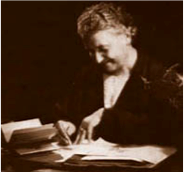Translating deep thinking into common sense
“Inspiration comes first, then teaching?”

By Marsha Familaro Enright
June 3, 2015
SUBSCRIBE TO SAVVY STREET (It's Free)
This is the third part of the four-part series on an ideal University Education; the first part is here and the second part is here.
“First We Must Inspire, Not Just Inform”
 Maria Montessori, pictured at left, noted that the student is a “spiritual embryo,” with his or her own innate pattern of growth ready to unfold, delicately and amazingly, given the right psychological and physical environment. The teacher’s role in this unfolding cannot be underestimated.
Maria Montessori, pictured at left, noted that the student is a “spiritual embryo,” with his or her own innate pattern of growth ready to unfold, delicately and amazingly, given the right psychological and physical environment. The teacher’s role in this unfolding cannot be underestimated.
Maria Montessori said: Teachers “have to conquer minds stirring up the great emotions of life,” to achieve real learning in students. In other words, teachers must tap into students’ deepest desires and values, such as love, joy, and pride, to motivate students. And, although Aristotle’s dicta “All men by nature desire to know” captures the human species’ trait of curiosity, curiosity can be squashed through ridicule or sapped through boredom by teachers—or coaxed into riotous flowering.
Great teachers are often transformative to the student, helping him or her learn to love knowledge and serious work, to acquire heightened reasoning skills, to look at many sides of a problem, to gather information from far-reaching domains in order to find solutions and to be self-reflective and reasonable–all important ingredients to future success.
Famed investor Warren Buffet, who did not want to go to college, said of his time achieving a master’s degree at Columbia University, “But I didn’t go there for a degree, I went for two teachers who were already my heroes.”
Although Aristotle’s dicta “All men by nature desire to know” captures the human species’ trait of curiosity, curiosity can be squashed through ridicule or sapped through boredom by teachers—or coaxed into riotous flowering.
These principles necessitate teachers of the highest order: those with the utmost respect for their students, who can teach by example and guidance through difficult material. To encourage the development of particular values and virtues in students, faculty become essential as role models. For example, by embodying great thinking, respect for independent judgment, and deep appreciation of individual freedom, the faculty model the very values of a free society, reason, individualism, and freedom.
While it is possible to be competent in communicating information and in conveying some of these traits long distance, in-person interaction is the most compellingly effective method. It’s important to have a program that actively uses technology of all kinds to creatively facilitate learning and collaboration and make scholars and public intellectuals from around the world accessible to students. But in-person classes with skilled, specially trained, role-model teachers are indispensable for a great education.
Let’s look at some ways teachers influence students.
Teachers and Activation Energy
Csikszentmihalyi notes that human beings have limited mental resources and energy when it comes to paying attention (focusing on material), and these should be used wisely. Hence, a good program keeps these factors in mind and seeks to facilitate attention. And interest is one of the key ingredients to minimizing the use of attentional energy.
A small group of people, like concert violinist Rachel Barton Pine, seem to find riveting interests when they are mere toddlers. This kind of person often barrels full speed ahead in what they want to do, but most people are not as definite or enthusiastic about any particular interest. Teachers can make a difference in the subjects in which students become interested and even in their choice of profession.
Often, a passionate teacher triggers an individual’s interest in a new subject. A previously unknown, boring, or distasteful field becomes the person’s area of professional interest through their teacher. I’ve seen many a student with no previous interest in, or maybe even a repulsion to, cicadas or worms, become enthralled with them after an enthusiastic teacher shows them the fascinating parts of the worm, the weird way the cicada flies, or how to eat it. The teacher fuels what research psychologist Csikszentmihalyi calls “activation energy,” i.e. the energy invested in learning to do something new.
Many complex and deeply engaging areas of knowledge and skill require an enormous amount of unrewarding work before they become enjoyable. Ballet dancing, mastering physics, or successfully managing employees are a few examples. Initially, the learner must expend intense mental energy in order to focus on the learning and become interested in the subject or skill: this is the “activation energy.” Learning a musical instrument is a good example: the student spends hours practicing physical movements and enduring awful sonic productions before acquiring enough skill to make enjoyable music!
In the early 20th century, Montessori noted the same phenomena and realized its connection to teaching: “I believed that at the start the teaching material had to be associated with the voice of the teacher which called and roused the [students] and induced them to use the material and educate themselves,” Maria Montessori.
A great teacher like the character of Edward James Olmos in the movie “Stand and Deliver,” or Robin Williams in “Dead Poets Society,” helps students through difficult material with contagious excitement and the ability to make it dramatically interesting and well-related to students’ deepest needs and values. This goes back to the principle that human interest drives learning.
Long-time Montessori teacher, Pat Schaefer, summed it up, “First: we must inspire, not just inform. Second: It is in relationship that the secret of [human learning] power is released.”
Teachers and Great Questions
On the precipice of full adult life, the college student needs answers to the great questions: “Why am I here?” ”How should I live?” ”How should I deal with other people?” “What should I do with my life?” If the student is not already asking himself these questions, it is his teacher’s job to show him how to ask them and how to find good answers.
Knowing how to pose the right questions can lead to a great awakening with unforeseen, amazing consequences. Forestry Consultant Charles Tomlinson often regaled friends and family with stories of his experience at The University of the South (called “Sewanee”) with “Abbo.” Charles claimed himself a rather complacent product of a middle-class Southern family when he encountered “Abbo,” English Professor Abbott Cotton Martin. Abbo spent considerable hours poking holes in everything Charles took for granted, from football to religion, with some English literature thrown in for good measure. This was Abbo’s stock-in-trade.
Abbo taught Charles to thoroughly question and examine what he thought he knew, as well as his beliefs. But Abbo didn’t just throw students in the water of quandaries, he made himself available to talk all during the week, not just during Sunday office hours. Charles learned to “check his premises” through Abbo’s prodding as well as via reading Ayn Rand. The other wonderful teachers at Sewanee helped too. They inspired him to demand more of himself, leading to a long, creatively productive, exciting life.
This included deeply influencing many people, including Jaroslav Romanchuk, a major figure in the opposition to Belarus’ authoritarian government.
Active Listening and Independent Judgment
“Be “careful not to ask [your] questions of the [students]. Only when [students] seek to answer questions which they themselves ask, do they commit themselves to the hard work of finding answers that are meaningful to them…give only as much guidance and encouragement as is necessary to elicit the [students’] interest.” Maria Montessori
Inspiration is the fundamental mission of the teacher.
Inspiration is the fundamental mission of the teacher, because of motivations’ deep importance to learning. Active Listening is a powerful teaching tool which promotes an inspiring relationship between teacher and student. For one thing, Active Listening conveys deep respect for the individual’s independence in thought and value.
 Active Listening is a key skill enabling teachers to nurture independent judgment. The Active Listener authentically tries to understand what the other person means, empathizing with the other’s point of view by working hard to grasp his or her full context. This means trying to understand the other person’s level of knowledge about a subject, their maturity level, the emotional issues affecting their thinking, and the set of ideas they are using to grasp the subject.
Active Listening is a key skill enabling teachers to nurture independent judgment. The Active Listener authentically tries to understand what the other person means, empathizing with the other’s point of view by working hard to grasp his or her full context. This means trying to understand the other person’s level of knowledge about a subject, their maturity level, the emotional issues affecting their thinking, and the set of ideas they are using to grasp the subject.
Active Listening promotes the spread of truth. Only by Active Listening do we end up having a full idea of what the other person means and thereby gain the opportunity to respond with appropriate facts and reasoning.
Used in teaching, this means the Active Listener asks clarifying questions about the student’s terms, respectfully allowing the student time to finish what he or she is saying before responding and, importantly, conveying an attitude of alert interest in what the student says.
The Active Listener must try to leave aside any personal feelings about the subject and squash the desire to assert and forcefully drive home the rightness of his or her own opinion. These actions only serve to distract a student from deep thinking and learning by bringing in issues of social hierarchy, personal power, and self-worth (i.e.: do I know enough, what does the teacher think of me, he’s got more status than I, I should listen to him). These issues elicit powerful, distracting emotions.
Further, the Active Listener tries to sense any motives in the student’s statements beyond the informational. For example, if a student in a class on Freud asks “What if a son is extremely fond and affectionate toward his mother—does that mean he has an Oedipus complex?” The teacher needs to be aware that the student’s study of Freud may have caused him to feel anxiety about his love for his mother. The teacher needs to respond with gentleness, general reassurance, and kindness.
Independent judgment is the wellspring of real choice, and good discussions nurture true individuality and judgment. Unfortunately these days, teachers sometimes find it difficult to conduct good discussions because students have been led to believe all opinions are equal in value and everyone should open their mouths to babble whatever they wish, no matter how inaccurate or trivial. Resulting from the reign of the Postmodernist attack on objectivity, this belief cripples students’ minds by encouraging them to think that any opinion is worthy, regardless of foundation.
Postmodernist ideology further deforms a student’s concept of self by equating diversity with group membership. In the Postmodernist schema, diversity primarily flows from race, ethnic background, or sexual preference rather than considered, ideological judgment. It promotes a collectivist concept of tribal or social diversity rather than true ideological difference.
While stoking their egos by making them feel whatever they think is important, this practice stops them from learning that true, valuable opinion must be grounded in facts and good reasoning.
Postmodernist ideology further deforms a student’s concept of self by equating diversity with group membership. In the Postmodernist schema, diversity primarily flows from race, ethnic background, or sexual preference rather than considered, ideological judgment. It promotes a collectivist concept of tribal or social diversity rather than true ideological difference.
In contrast, Active Listening conveys a deep respect for the independence of the other person’s mind: the Active Listener takes the student’s ideological point of view seriously and tries to respond to it carefully. The aim of Active Listening is full understanding of what the other is saying in the service of arriving at truth. Just imagine the kind of productive political discussions we all might have if we used these principles!
Some people have a rare, natural ability or tendency to listen like this, but since it can be learned, there’s hope for the rest of us. It is also typical of Montessori teachers, because of their deep training in careful observation of students.
For university students, we can bring together all the elements discussed here through a specific way of crafting curriculum using a particular methodology which teachers can use.








Hi Marsha, I have been enjoying reading your articles. You haven’t lost your touch!
Thank you! Sorry for the late reply – the comments are not being pushed to my email!! Have to figure that out…